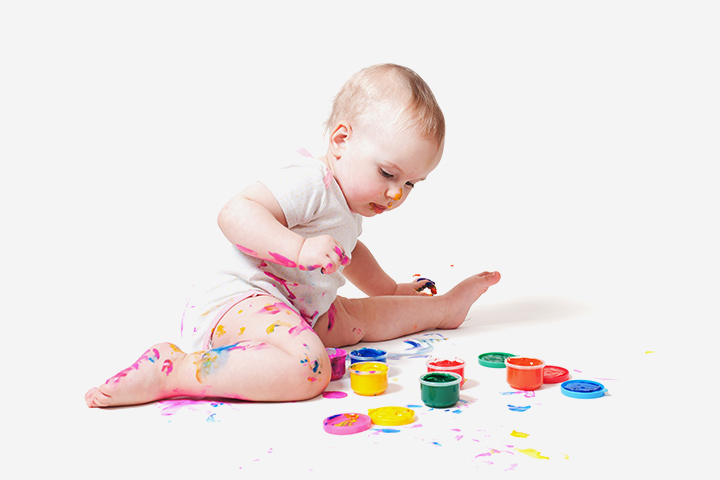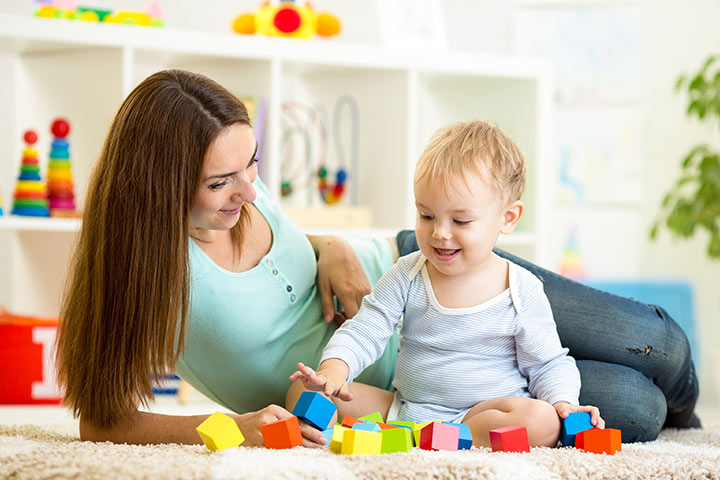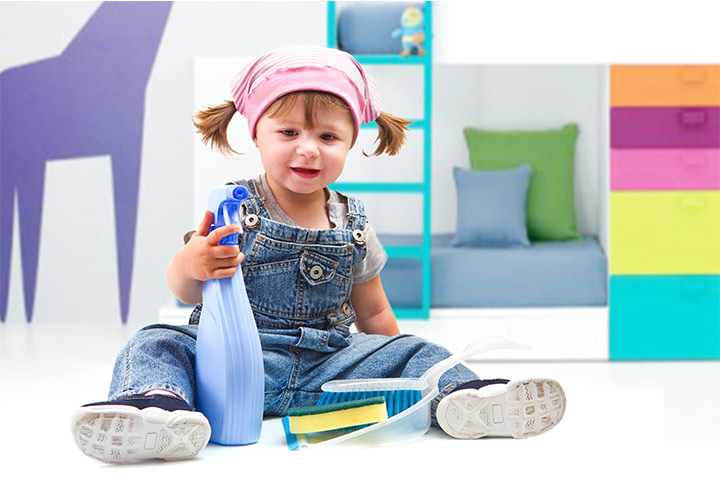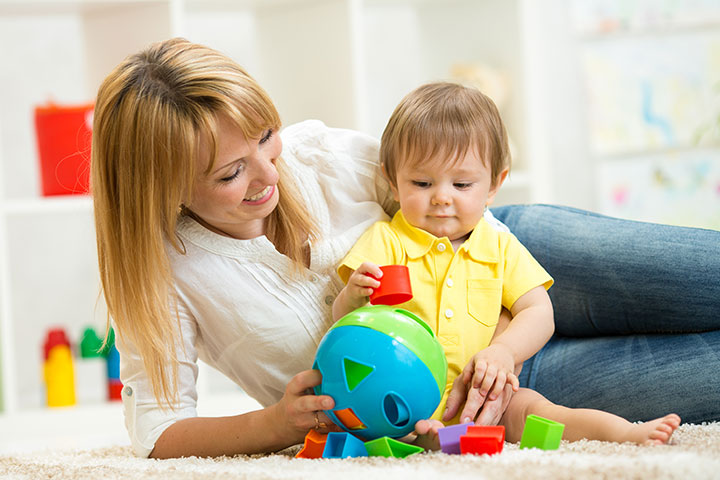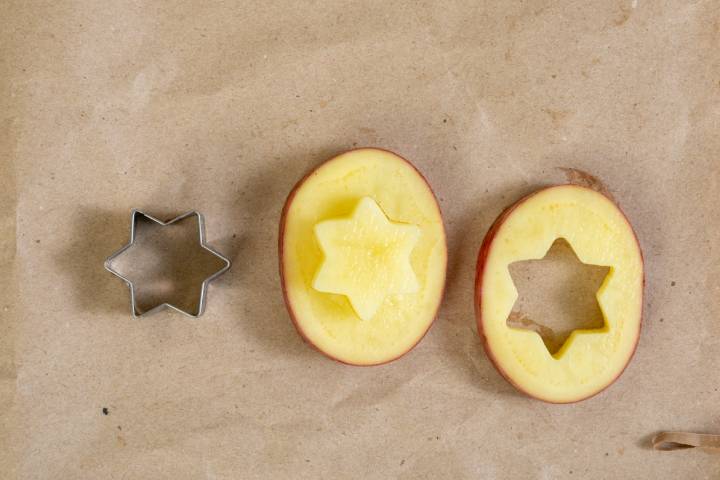Children reach their developmental milestones at their own pace. If you are looking for the best activities for a 20-month-old-baby, you are at the right place. With your adorable toddler growing up and learning to communicate and socialize, it’s a nice idea to introduce them to some interesting activities. And if you have run out of ideas already to help them have a fun learning experience, here we are with a list of some amazing toddler activities. Read on to know more.
Six Activities For Your 20-Month-Old
Here are six fun activities that your 20-month-old toddler will love:
1. Smear it on
You Will Need:
- Finger paints.
- Wax paper
- Plain paper
- Tape
How To:
1. Place the wax paper on a solid surface and tape it up to avoid slippage. Tape the plain paper over this.
2. Drop a small amount of paint onto the paper. Dip your finger in it and show your toddler how she can smear it. Let her listen and try.
3. Once she knows what to do, pour more colors to make it interesting. Gradually teach her about the colors she is using so she can better identify them.
4. The activity will help develop your toddler’s motor skills. It is a great way to introduce her to colors with which she can draw later.
2. Look for it
You Will Need:
- A small toy or object that will fit easily in your palm
How To:
1. Show your toddler the object.
2. Now place it in your palm and make sure your toddler is watching. Slowly close your fingers around the object to hide it from view. Now put your hands behind your back.
3. Ask your toddler ‘where is the toy’ and slowly bring your hands to the front.
4. Ask her to point at the hand in which she thinks the object is. Open the fist slowly to show her whether the object is there or if your hand is empty. Once she finds the object, express surprise and happiness.
5. The activity will teach your toddler about object permanence and observation. It is also so much fun for a 20-month-old.
Once your toddler gets a hang of this game, you can increase its scope to an entire room. Nicole Duggan, mother of two boys, does exactly this and discusses how these learning activities keep her toddler happily occupied while promoting valuable experiences. She shares, “Puzzles are one of my child’s favorite toys right now! G (her 20-month-old younger son) is so much more into puzzles than M (5.5 years old) ever was.
“Sometimes we hide the pieces around the room (in easy spots) and he finds them and completes the puzzle. It’s a creative way to make the puzzle more exciting (i).”
3. Helping hand
You Will Need:
- A small clean broom
- A clean cloth
How To:
1. Start by wiping a safe place using a clean cloth. Try choosing a surface that your toddler can easily access. It should not have anything potentially harmful.
2. Make sure your toddler is watching you as you do this so they can mimic your actions.
3. Give the cloth to your toddler and ask her to clean up the place. You can also sprinkle a few drops of water on the surface to give your toddler more things to clean.
4. The activity will help your 20-month-old toddler develop her gross motor skills.
4. See the world
You Will Need:
- Any safe place where you can spend free time with your toddler
How To:
1. Make sure you have plenty of time at hand. Choose the time of the day when your toddler is happy, energetic, well-fed, and rested.
2. Take your toddler to a nearby park or garden, or even the nearest mall or shopping complex.
3. Let your toddler show you the path. Follow your toddler and see all those things that seem fascinating to her.
4. Do not rush her to move on, even if it seems she is doing nothing but standing and staring.
5. The activity will give your toddler a chance to learn about the world at her pace.
5. Match it
You Will Need:
- Any object that your toddler also has a copy of – socks, a hair clip, a book
How To:
1. Make sure you do this activity in a place where your toddler has easy access to her things.
2. Hold up an object from your stash and show her. Name the object.
3. Now ask her to find the same. For example, if you are holding out a sock, tell her ‘it’s mamma’s sock, can you show me your sock?’
4. Applaud her when she manages to seek a similar object.
5. The activity will teach your toddler about various objects, sort them, and help them grasp basic matching.
6. Stamp it out!
You Will Need:
- Potatoes
- Knife
- Paper or cardstock paper
- Paint
How To:
1. Cut the potatoes in half and form simple shapes like hearts, stars, or circles.
2. Lay the paper or cardstock on a flat surface and pour small amounts of colored paint onto a palette or plate.
3. Show your toddler how to dip the potato stamp into the paint, ensuring the carved shape is well-coated.
4. Allow the toddler to explore and create their own designs. They can stamp multiple shapes, mix colors, or overlap stamps.
5. This activity is best for sensory exploration and creative expression.
Note: Make sure to keep your toddler away from sharp tools like knives.
These activities for a 20-month-old baby will help you keep your child engaged and also teach them specific vital skills. Be it matching activities or taking your little one outdoors for a walk and letting them explore things from their perspective, it helps them develop their cognitive abilities and improves their social knowledge. Keeping your child engaged in such activities also helps them be productive and reduces screen time. Remember to let your child do everything at their own pace and not try to force them so that they can enjoy and make the most out of the learning process.
Key Pointers
- Children have their own unique pace for reaching developmental milestones.
- Toddlers can learn and enjoy themselves with interesting activities.
- At 20 months old, activities like finger painting, object permanence, gross motor skills, exploring the world, and basic matching can be introduced.
- These activities aid in the development of motor skills, object recognition, and observation.
Learn how to play with your 20 month old toddler! Discover developmental milestones and activities to help your baby grow. Get tips and tricks to make playtime fun and educational.

